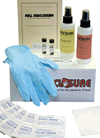
10 Common First-Aid Mistakes. Avoid the myths and learn the realities of first-aid in this Red Cross sponsored whitepaper.
Sponsored by American Red Cross

In the United States, there
is a flu season that begins every fall
and ends every spring. The type of
flu people get during this season is
called seasonal flu.
Sponsored by American Red Cross

According to the Federal Communications Commissions (FCC), over 50 million people now use wireless phones to call 9-1-1. That is more than double the number who used wireless phones to activate EMS in 1995.
Sponsored by American Red Cross

Standing, sitting, and moving incorrectly all increase your risk of musculoskeletal disorders (MSDs)—injuries often associated with repetitive strain or damage to muscles, tendons, nerves and joints.
Sponsored by American Red Cross

The most critical steps toward lead hazard abatement are contaminant identification and removal. Researchers from CDC/NIOSH have developed two simple and reliable technologies to achieve these steps easily and without the need for extensive training.

Public health experts warn pandemic influenza poses a significant risk to the United States and the world—only its timing, severity, and exact strain remain uncertain. International, Federal, State, local, and tribal government agencies are diligently planning for the public health response to this potential pandemic. The disease could be severe and could affect our critical infrastructure and our nation’s economic and social security. It is important that you take action.

In anticipation of the EPA's expected change to the Noise Reduction Rating (NRR), Howard Leight has issued a brochure that explains known details of the proposed changes for hearing protectors. Titled, "Inside the EPA's Proposed Change to the Noise Reduction Rating," the brochure is designed as a handy information resource for safety managers, providing background on the impending new rating system and the ANSI testing protocols on which it is expected to be based.
Sponsored by Howard Leight

Keeping workers properly protected from hazardous noise and motivated to wear their hearing protectors is a challenge for any safety manager. With proper training and ongoing encouragement, most workers do wear their earplugs or earmuffs on the job. However, there are always a few workers who feel compelled to raise objections instead of just donning their hearing protectors and getting on with the job.
Sponsored by Howard Leight

Sponsored by PlantMentor® from RWD Technologies
What comes to mind when there is a toxic chemical release? The most obvious responses
involve evacuation or shelter in place of the people in the path of the plume. To predict the path, area, and severity of a plume impact, you need a dispersion model. The basic information required to initiate a dispersion model is weather data, identification of the chemical, and the rate of the chemical release. However, the Achille' heel of this information is the release rate specification: "How big is the hole?"
SAFER Systems has developed and patented a unique scheme for estimating the release rate. The algorithm to implement the scheme is called Advanced Back Calculation® (ABC). The idea basically involves “reverse engineering” a dispersion model. While we usually input the release rate to the dispersion model and obtain the concentration field for the plume-impacted area, in ABC we utilize the concentration field data to estimate the release rate.
Sponsored by SAFER Systems LLC